IMAGING
REPORT
Subject:
Madonna and Child with the Infant St. John the Baptist
ref.: AAR0748.A
Date: 1 August 2016
Dr.
Nicholas Eastaugh
Dr. Jilleen
Nadolny

A.
Introduction
The
subject of this study is a painting depicting the Madonna and Child
with the Infant St. John the Baptist (Private Collection, Moscow)
and its relationship to a series of associated works, part of a
larger project undertaken by Thereza Wells looking at how these
paintings might be placed within the artistic output of Leonardo da
Vinci, his studio and followers. The ensuing report presents the
work done by Art Analysis and
Research in imaging some of these related paintings and provides some discussion of the technical findings but does not otherwise address the
issues of specific authorship.
Four
related works were subjected to scrutiny in the imaging campaign
conducted by AA&R between October 2015 and March
2016:
x
A version attributed to Fernando Llanos or Fernando Yanez de la
Almedina in the Galeria Palatina, Florence; x A version given to
‘Circle of Leonardo da Vinci’ in the Ashmolean Museum, Oxford; x A
version attributed to Marco d’Oggiono in the Museum of Fine Art,
Budapest; x A
version given to a ‘Follower of Leonardo da Vinci’ (possibly Niccolo Soggi) in the collection at Buscot Park, Oxfordshire.
In
addition, both the Moscow version and another work, normally at
Château de Flers, Villeneuved’Ascq, France but currently with C2RMF
in
Paris pending conservation, were viewed and copies of imaging work performed earlier by others were examined.
During
examination of these artworks some additional documentation was
undertaken, such as confirmation of dimensions, certain panel
details, examination with ultraviolet fluorescence (not otherwise
documented photographically), and limited recording of technique
through
low-power surface microscopy. However, this documentation has not been further dealt with here.
Finally,
the following documentation relating to the Moscow version
comprising reports prepared during recent conservation work on the
painting (2014-15) and supplementary analytical studies were also
shared with the present author:
x
A Report of a Technical Examination carried out by Silvia Amato at
the Courtauld Institute of Art, University of London (their ref.
CIA
2315), dated 5 May 2014 but stated to relate to examination in the period 6 May to 3 June 2014; x A Conservation Report by Keith and
Sauerberg Ltd., dated 22 April 2015, relating to their treatment of the painting; x An Expert Examination Report by Dr. Alexander Kossolapov (May 2015), incorporating and interpreting data from prior materials analysis noted above and X-radiography of the painting undertaken by the
Courtauld Institute of Art, and infrared reflectography by Tager Stonor Richardson, London; x Results of further scientific analysis of two paint cross-sections previously taken and prepared as part of the Courtauld Institute of Art study, which were analysed with elemental mapping and
Raman (dated 21 April 2016); x Results of a limited in situ X-ray fluorescence study of the painting performed to examine the possible
presence of a metal-point underdrawing (provided 6 June 2016).
Further comment on these documents will be necessarily limited in nature here as they were not performed by AA&R and cannot therefore be
fully evaluated, especially in the absence of the original data. Data has, additionally, been generated by and collated from a number of separate sources with different scope and capabilities, making cross-comparison and interpretation more difficult and less reliable. It should also be
noted that some of the analyses and imaging were apparently constrained in extent (for example the materials analysis, including pigment
identification and stratigraphy, as well as the X-radiography of the Moscow version) making interpretation further problematic.
Finally,
this report has been prepared in parallel with that drawn up by
Thereza Wells (Report on the Virgin and Child with the Infant St
John the Baptist, Moscow, private collection; dated July 2016) and
should therefore be consulted in conjunction with that
work.
B.
Imaging process
The primary motivation for the imaging campaign was to collect data on underdrawing that might be present in the various works. To that end a
mobile solution was implemented capable of providing high-resolution infrared in two ranges based around a silicon sensor (IR to ~1100nm)
and an InGaAs sensor (IR to ~1700nm). The former system has much higher spatial resolution allowing better imaging of fine detail while the
latter system has typically superior IR performance towards penetration of paint layers but much lower intrinsic spatial resolution. It has been
found in practice that use of both systems in conjunction allows additional benefits to be derived. In addition, the silicon system is readily
converted to record other image types, notably colour, so that high-resolution images of the paintings under study could be captured for subsequent reference. Results of the programme have been included with this report as overall images, though the digital versions are to be considered the primary product. Full details of the imaging systems used and subsequent processing are also appended here. In addition, some
relevant images provided by
other sources have also been incorporated so as to provide a single
point of general reference.
As noted above, during the imaging exercise some other limited examination of the paintings was conducted as time and resources permitted
and relevant additional data collected. For example, some images were collected showing surface conformation, including informal
photographs documenting oblique illumination, more formal ‘raking light’ photography and a set of images of the Ashmolean painting taken
using reflectance transform imaging (‘RTI’). This data has not been incorporated here however as it is incomplete and not well-suited for direct
inter-comparison between the various paintings.
It
was also possible to collect images of some paintings (Budapest,
Buscot Park and Florence) using a portable microscope system. This
permitted documentation of various details of the technique of the paintings. Again, results have not been incorporated here but are available for consultation.
C.
Comments
As
noted by Thereza Wells in her detailed report, there is
considerable variation in technique between the various versions of
the painting
examined. This extends to the nature of the underdrawing. Of the four core paintings the Florence version did not show detectable
underdrawing, the Ashmolean version is so damaged that interpretation is considerably difficult, the Château de Flers painting exhibits quite
extensive underdrawing with a distinctive hand, and the Moscow version has underdrawing but the full form and extent is difficult to determine. Of the remaining versions examined, those in Budapest and Buscot Park were both found to have extensive and characteristic underdrawing
present, well-suited to further research. While the underdrawing on three paintings was sufficiently legible to allow for inter-comparison, in each of the three cases, the character of the drawing seemed distinct; thus, little basis for comparison or establishing stylistic relationships could
be found.
The
absence of detectable underdrawing in the Florence version and the
difficulty of imaging that in the Moscow version could in principle
be
explained by the use of metalpoint. To explore this, limited elemental analysis using portable in situ X-ray fluorescence and the results supplied
to AA&R as noted earlier. The specific instrument applied was an Olympus Delta Professional portable XRF analyser, thought to be based on a rhodium target. Measurements were taken to coincide with a line identified from an infrared image captured using an Osiris-type camera, then approximately 15mm away from it (Figure 1). Silver was detected in the vicinity of the line, with estimated Ag content of ~300 ppm for the underdrawing and < 8 ppm away from the line. These very preliminary results would seem to warrant further research and critical evaluation.
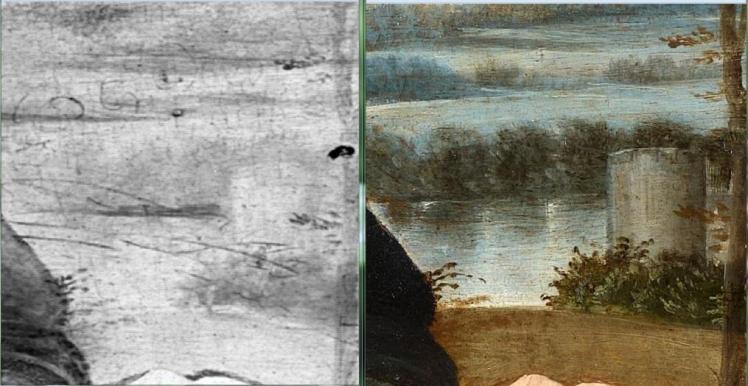

Figure 1. Results of XRF examination of possible underdrawing in the Moscow version.
IMAGES
The ‘Core’ Group
1. Madonna and Child with the Infant St. John the Baptist Oil, tempera and gold on poplar; 71.8 x 50.5cm Private Collection, Moscow [Viewed
but not imaged by AA&R] [Recto, IR, X-ray, verso]
2. Madonna and Child with the Infant St. John the Baptist Attributed to Fernando Llanos or Fernando Yanez de la Almedina Oil on panel; 73 x 50cm Galeria Palatina, Florence [Viewed and imaged by AA&R] [Recto, IR (Si CMOS), IR (InGaAs)]
3.
Madonna and Child with the Infant St. John the Baptist Circle of
Leonardo da Vinci Oil on panel, possibly linden; 72.2 x 50.5cm
Ashmolean Museum, Oxford [Viewed and imaged by AA&R] [Recto, IR
(Si CMOS), IR (InGaAs)]
4. Madonna and Child with the Infant St. John the Baptist Attributed to Cesare da Cesto Oil on panel; 75 x 53cm Château de Flers, Villeneuve-d’Ascq, France. Currently in Paris. [Viewed but not imaged by AA&R] [Recto, IR, X-ray, UV fluorescence, verso]
Budapest
5.
Madonna and Child with the Infant St. John the Baptist Attributed
here to Marco d’Oggiono Oil and tempera on panel, possibly linden;
113 x 76.5cm Museum of Fine Art, Budapest [Viewed and imaged by
AA&R] [Recto, IR (Si CMOS), IR (InGaAs)]
The Tondo Group
6. Madonna and Child with the Infant St. John the Baptist Follower of Leonardo da Vinci (Niccolo Soggi?) On panel; 95.25cm diameter Buscot
Park, England [Viewed and imaged by AA&R] [Recto, IR (Si CMOS), IR (InGaAs)]
7. Madonna and Child with the Infant St. John the Baptist Follower of Leonardo da Vinci [Unknown size/support] Gallarati Scotti Collection, Milan [Not viewed or imaged by AA&R] [No technical images available]
8. Madonna and Child with the Infant St. John the Baptist Follower of Leonardo da Vinci [Unknown size/support] Location unknown; formerly
in the Lockinge Collection, England [Not viewed or imaged by AA&R] [No technical images available]
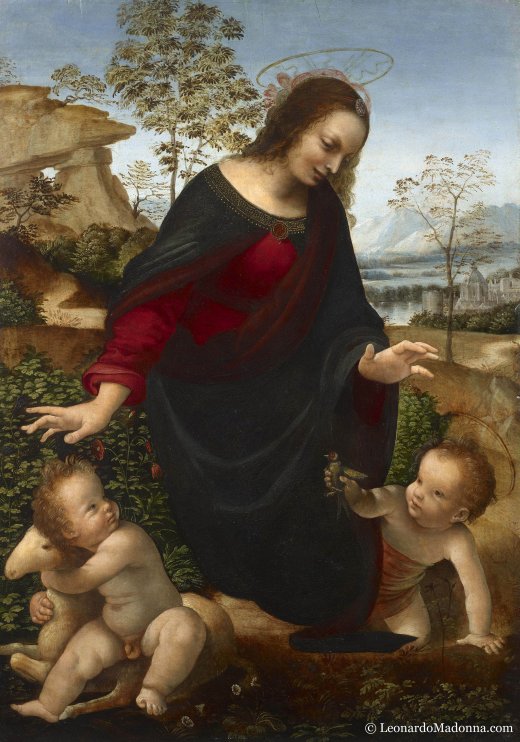
Painting 1: Private Collection, Moscow (image supplied to AA&R).
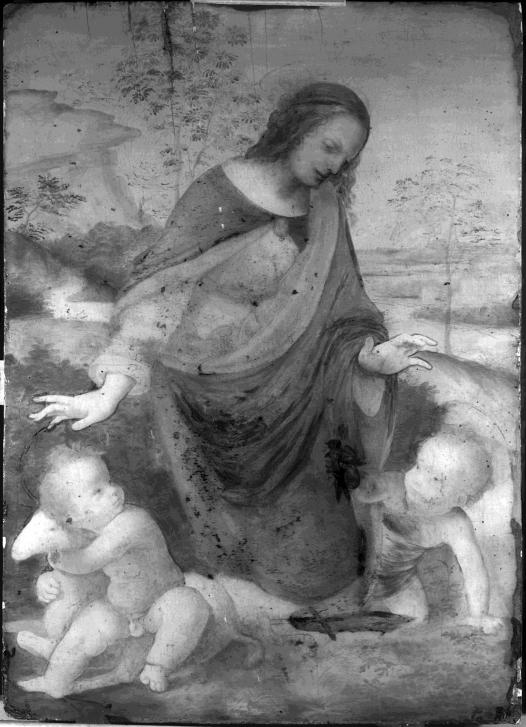
Painting 1: IR to 1700nm, (image supplied to AA&R).

Painting 1: X-radiograph, (image supplied to AA&R).

Painting 1: Verso, (image supplied to AA&R).
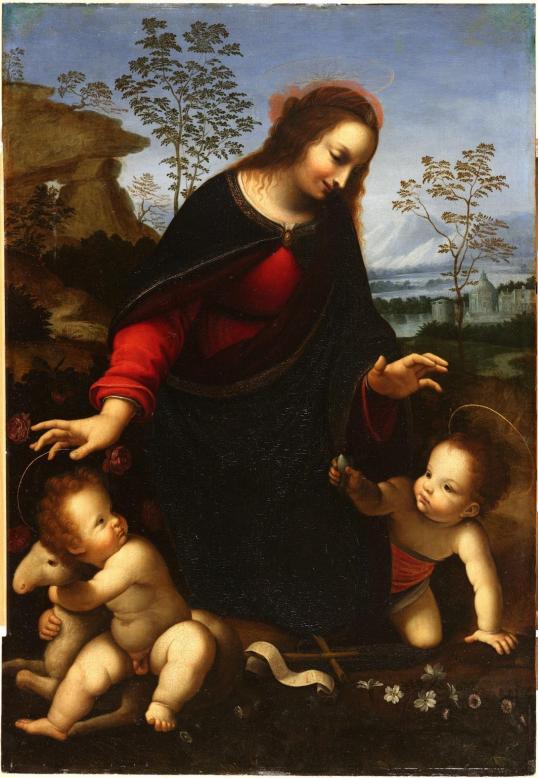
Painting 2: Galeria Palatina, Florence (image AA&R).
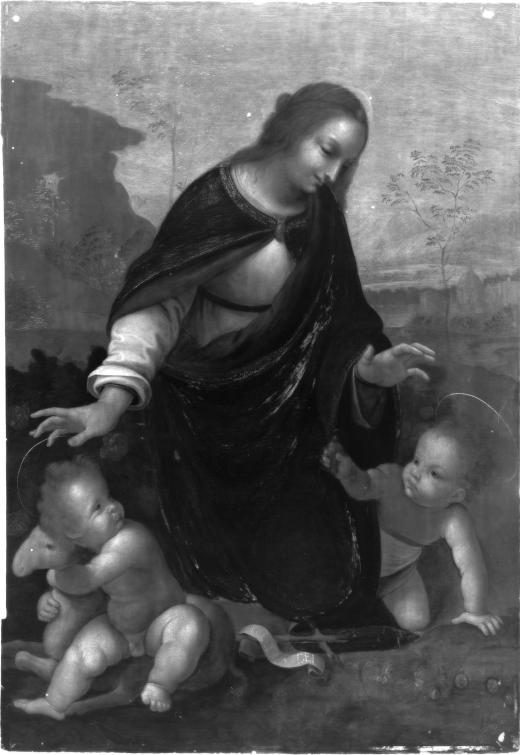
Painting 2: IR (InGaAs), (image AA&R).

Painting 2: IR (Si CMOS), (image AA&R).
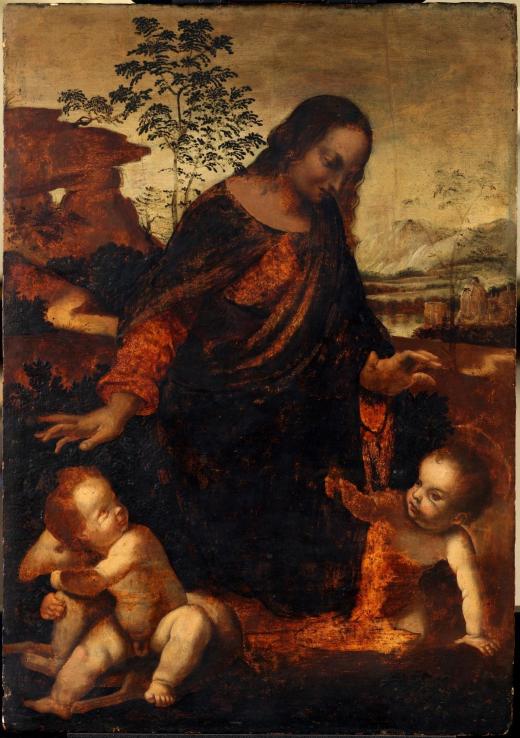
Painting 3: Ashmolean Museum, Oxford, (image AA&R).
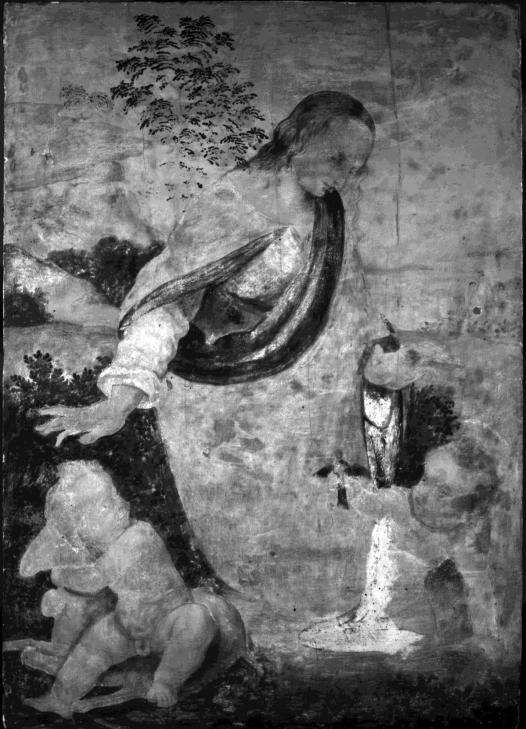
Painting 3: IR (InGaAs), (image AA&R).
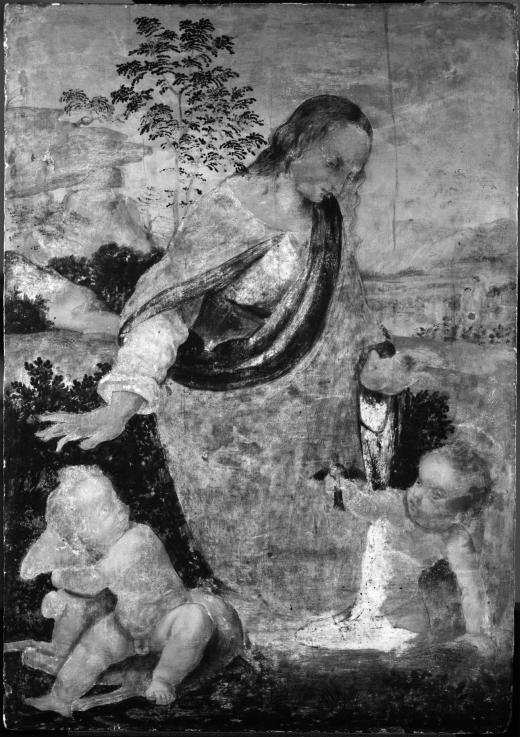
Painting 3: IR (Si CMOS), (image AA&R).
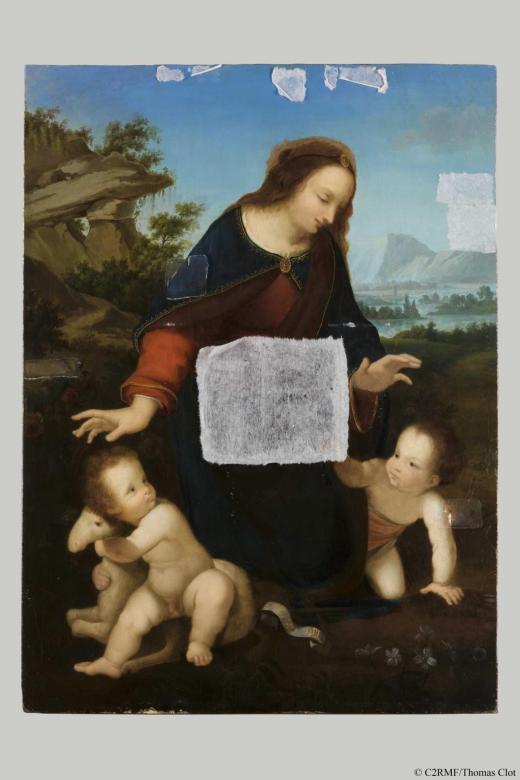
Painting 4: Château de Flers, Villeneuve-d’Ascq, France, ©C2RMF.

Painting 4:
IR (900-1700nm),
©C2RMF.
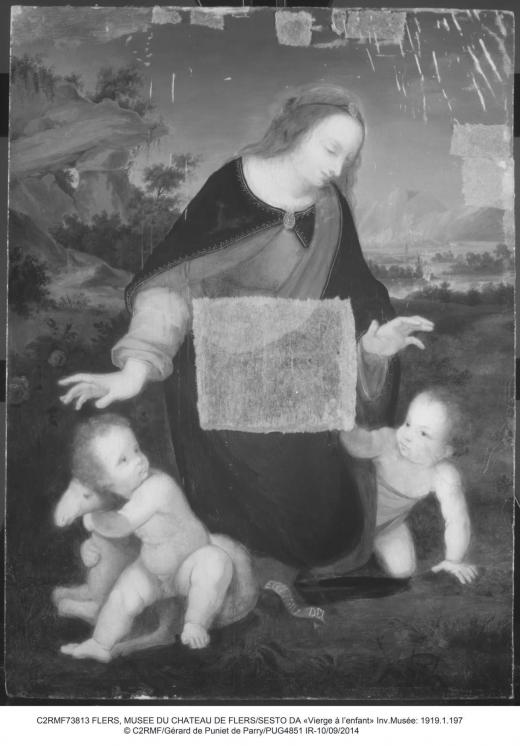
Painting 4: IR (type not further specified from source), ©C2RMF.

Painting 4: UV fluorescence, ©C2RMF.

Painting 4: Verso, ©C2RMF.
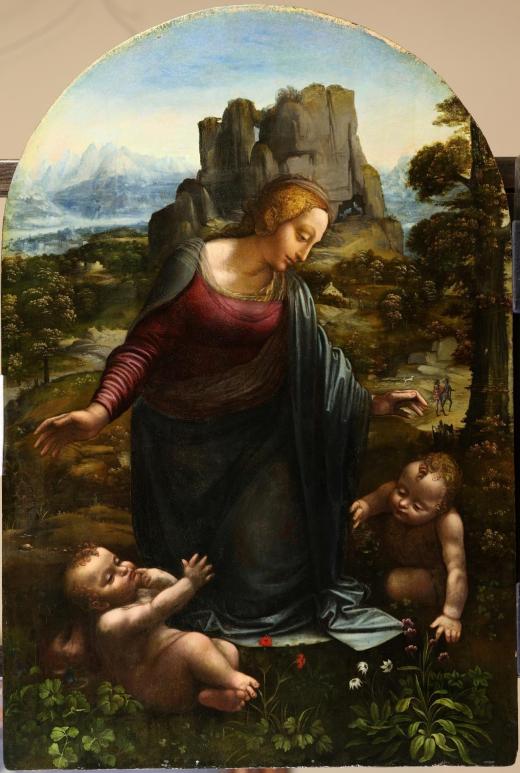
Painting 5: Museum of Fine Art, Budapest, (image AA&R).

Painting 5: IR (InGaAs), (image AA&R).

Painting 5: IR (Si CMOS), (image AA&R).

Painting 6: Buscot Park, Oxfordshire, (image AA&R).
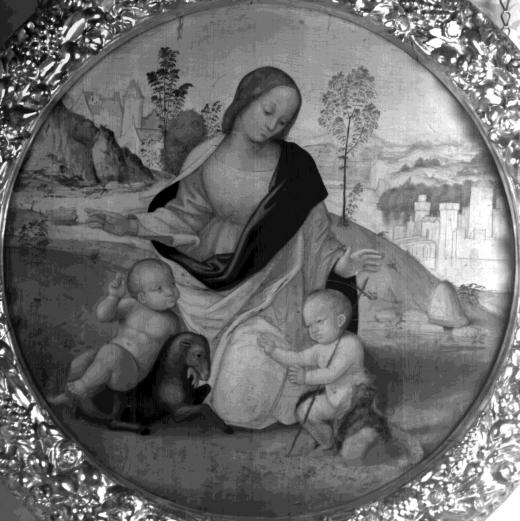
Painting 6: IR (InGaAs), (image AA&R).

Painting 6: IR (Si CMOS), (image AA&R).
Equipment used (AA&R images only)
Si CMOS camera: Equipment used was a Canon 6D camera[1] modified by Advanced Camera
Services2 to replace the normal internal infrared filter with a quartz filter. This in principle enables sensitivity across the full spectral range of
the Si-based CMOS sensor although actual response also depends on other elements of the optical train. The lens system used in this instance was a Canon EF 400mm f/5.6L USM[2].
For colour images a secondary filter type, an X-Nite CC1 (Color Correction 1)4, is added to replace the infrared filter removed in the modification that allowed full spectral range sensitivity.
For infrared images an X-Nite 850 (850nm IR long-pass filter) is added. This allows only light in the near infrared to pass through to the sensor. Illumination was provided by a pair of 1000W photographic flood lamps. Images were captured simultaneously in native Canon Raw (*.CR2)[3]
and JPEG (*.JPG)[4] formats onto the internal SD memory card of the camera, then transferred for further processing. (Original versions of the images were also archived.)
For colour imaging, the key step in assuring accurate representation of the colours present is setting the white balance. To achieve this an X-rite ColorChecker White Balance[5] is placed in front of the painting and used to make an accurate white point measurement. The white card image is then used to set the camera’s white point for the subsequent imaging process. The next step is to take an image of a colour calibration target
(X-rite ColorChecker Passport Classic Target[6]). This is to ensure an accurate colour profile can be produced in the post-processing stage from
the Canon Raw files. Infrared imaging ultimately produces monochromatic images so the selection of a white balance point is not required.
InGaAs camera: Equipment used was a VDS Vosskühler NIR-300PGE infrared camera with a cooled
320 x 256 pixel InGaAs sensor of spectral sensitivity from 0.9-1.7µm and a 12-bit output via a Pleora Gigabit Ethernet interface[7]. The lens
system used was a Canon EF 400mm f/5.6L USM[8] with Cmount adapter. While specially-designed SWIR lenses targeted at the 0.9-1.7μm
range of the InGaAs sensor would normally be preferred it has been found in practice that these Canon lenses nonetheless perform well. Data
acquisition was via the Pleora interface, with four images saved for each position. This is to allow for the application of super-resolution methods at a later date. Each image is saved in a native 16-bit raw format and an 8-bit BMP11 format. The BMP image allows the operator to examine image outputs during capture run time and the raw image is post-processed and used for the composited image. The camera is calibrated using a flat-field correction. This is done by producing a dark-frame image (image taken with lens cap on which means no light is falling on the sensor) and a flat field image (image of a flat white target placed in front of the object to be imaged). A good description of the
various corrections required for effective capture of mosaic images may be found in Martinez et al (2002)[9].
GigaPan system: Both cameras were mounted on a GigaPan EPIC Pro[10], which enables efficient collection of image ‘mosaics’. Image capture
on the Canon 6D was triggered directly from the EPIC Pro, while the Vosskühler camera was integrated using a custom-built trigger (AA&R) based on an Arduino Micro[11]. The capture cycles were varied to either allow long settle time (Canon 6D) or acquire multiple images under vibration (Vosskühler; 4-10 images). The reason for this is that the capture times for the Canon 6D are relatively long and affected strongly by vibration, therefore vibration is undesirable. With the Vosskühler the capture times are short compared to the vibration and this can be exploited
to achieve sub-pixel shifting for super-resolution imaging; while sets of subimages were collected in this instance further reconstruction has not been performed.
Image processing
Si CMOS images: To produce colour images that represent colour accurately the image of the ColorChecker Passport Classic Target, taken prior to the imaging of the painting is used to produce an ICC[12] profile in Argyll Color Management System (Argyll CMS)[13]. The Raw .CR2
files produced by the camera are converted to 8-bit TIFF files in RawTherapee[14] using the internal white point set prior to imaging with the
ColorChecker White Balance and the ICC profile generated in Argyll CMS.
The TIFF files were then composited using Microsoft Research Image Composite Editor (ICE)[15] and post-processed in Adobe Photoshop CS4 to allow for easier interpretation by analysts. This consisted of cropping, using the warp function to correct geometric distortion introduced through the imaging and compositing process, adjustments to contrast use of the Smart Sharpen function to enhance readability.
The post-processed TIFF or JPEG files from all techniques are then composited using Microsoft Research Image Composite Editor (ICE)[16]. The image is then processed in Photoshop to allow for easier interpretation by analysts. This process consists of cropping, using the warp function to correct geometric distortion introduced through the imaging and compositing process, adjustments to contrast use of the Smart Sharpen function to enhance readability. In addition, the infrared image is converted to an 8bit grayscale image.
InGaAs images: Corrected images were created from the 16-bit raw images with an applied flat-field correction using the flat field and dark
field images taken alongside the images of the object. The corrected images are output as an 8-bit BMP image.
The post-processed BMP files are then composited using Microsoft Research Image Composite Editor (ICE)[17]. The image is then processed in Photoshop to allow for easier interpretation by analysts. This process consists of cropping, using the warp function to correct geometric distortion introduced through the imaging and compositing process, adjustments to contrast use of the Smart Sharpen function to enhance readability.
[1] http://www.canon.co.uk/For_Home/Product_Finder/Cameras/Digital_SLR/EOS_6D/index.aspx. 2http://www.advancedcameraservices.co.uk/.
[2] http://www.canon.co.uk/For_Home/Product_Finder/Cameras/EF_Lenses/Telephoto/EF_400mm_f5.6L_USM/. 4http://maxmax.com/aXNiteFilters.htm.
[7] Now Allied Vision Technologies. See: http://www.alliedvisiontec.com/emea/products/cameras/vds-vosskuehlerlegacy.html.
[8] http://www.canon.co.uk/For_Home/Product_Finder/Cameras/EF_Lenses/Telephoto/EF_400mm_f5.6L_USM/. 11http://msdn.microsoft.com/en-us/library/windows/desktop/dd162461%28v=vs.85%29.aspx
[9] Martinez, K.; Cupitt, J.; Saunders, D.; Pillay, R., ‘Ten Years of Art Imaging Research’, Proceedings of the IEEE, 90, #1 (2002) 28-41.